Planning a family trip where you’re flying with children? Whether you go ‘low cost’, or use a full service airline, flying with children is a challenge, so most of our tips will be relevant. So if the tickets are in order, passports are current and any visas are done, let’s fly!
We recently flew AirAsia X (low cost) from Kuala Lumpur to Gold Coast and survived to tell the tale. Our party consisted of 7 people – mum and dad and three children aged 3, 5 and 7. We were fortunate to have grandparents as backup – an extra two pairs of hands and eyes. However, similar journeys have been done over the ears, in various combinations, starting with one parent and one 6 month old.
Flying with children
We looked at eight main areas which are possible crisis points. Some will be more important that others, depending on age, reasn fr travel, personalty, length of journey and the airline’s approach to children. For general travelling, check out our 10 tips to stay sane! They’ll also apply here.
Involve them
Whether your children fly often or seldom, or this is their first trip, get them involved.
- Give them some responsibility for their own hand carry bag.
- If they’re old enough they can pack it themselves.
- Making a check-list is a good idea.
- Check that they’ve included everything!
- Remove the unnecessary additions and explain why.
- First timers will benefit if you explain the processes involved in planning, packing and flying.
- Age appropriate, of course.
- Let them help check-in, they’ll understand why you were weighing the bags for starters.
- it makes life much easier as it shares the load.
Which flight?
Choosing the timing of your flight can make a big difference to the outcome. Our airline had both day and night flights available during the period we wanted so we chose one of each. Night out, day coming home.
- One important factor to consider is any time difference between departure point and destination.
- Our trip time was 8 hours, with a 2 hr earlier time difference.
- With our midnight departure, our expected arrival time was just after 10am local time, 8am at ‘home’.
- This is a small difference, but as you wake up earlier on an overnight flight eastwards, everyone will still be tired.
- Both children and adults may need time to adjust, even for a small time difference. Factor in rest time.
- The longer your journey and the more time zones you cross, will need different strategies.
- If it’s possible to break the journey, this can help.
- Another suggestion is to adjust to the arrival location, time & meal-wise as soon as you take off.
- Night flight (overnight, 7-8 hrs or more)
- You have the day to get organised, rather than an early morning wake-up and rush.
- Allow enough time to reach the airport, especially if you’re unfamiliar with the layout and procedures.
- Have a light meal after you’ve checked in, leave plenty of time to reach the boarding gate.
- An overnight flight allows you to rest, if not enough sleep.
- The excitement of the holiday compensates for the lack of sleep. (At least for the kids!)
- Make sure the designated driver gets some sleep.
- Most airlines will keep the lights dimmed long enough for passengers to get some sleep.
- Eat breakfast before landing, rather than a meal following take off, if it’s a late night departure.
- Be careful using medication to help children sleep, especially if they haven’t taken this before. Some medications can have unexpected effects.
- The focus is on sleeping, so if everyone is comfortable, the children don’t need something to do.
- Day flight
- For early departures, pack the night before.
- Set the alarm!
- You can see where you’re going, if you have a window seat.
- You may arrive with time left to go exploring before bedtime.
Which seats?
- Plan for easy access.
- A 3/3/3 seat layout makes it difficult for the window seat passenger to get in an out.
- If there’s a 2/3/2 or 2/4/2 layout available, the inside passenger only has to climb over one other person to get in/out.
- Aircraft narrow towards the back, so the rear of a wide-body aircraft will likely have a 2/3/2 for a number of rows.
- The AirAsia X A330s have this arrangement, which was great for our party of 7.
- Seats are close to the toilets, useful when kids need to go.
- The waiting area at the back generally has more space than toilets in the middle of the plane and it’s also easier to move from one side to the other.
- Children aren’t allowed to sit in Exit Rows for safety reasons.
- Seats behind the engines are generally noisier.
- Some airlines have a ‘Quiet zone’ towards the front where children under 12 aren’t allowed.
- Many airlines have similar restrictions on Business or Premium class sections.
- If your airline has bassinets available, please note:
- the bassinet is attached to the bulkhead wall at the front of the cabin
- it occupies your legroom and can restrict access, especially for ‘in side’ passengers
- bassinets are for infants who don’t have their own seat, so you have to carry them when they’re not using it.
- the child must be removed from the bassinet if there is turbulence.
- sleeping may be difficult. For ideas making this more comfortable, check out the covers at CoziGo.
Be comfortable
- Clean teeth and change into comfortable clothes.
- Have a change of clothes ready and do a quick change in the first toilet when you arrive.
- The change is also handy if you have a drive ahead of you to your destination.
- Have a toiletries bag ready for face washing and general clean-up.
- Many younger children will feel comfortable with their own pyjamas, blanket and pillow.
- Neck pillows can be carried over the pull handles of carry-on bags.
- Car seats are compulsory for use by children in many countries, including Australia.
- Car Seat Hire can be expensive, or you can take your existing seats with you, if they are suitable.
- If your child is already using a forward facing carseat, most airlines will allow this in the cabin, for free.
- The child must be three years old or below and able to use the seat.
- They must have their own paid seat.
- If they’re used to sleeping in the seat in the car, this makes sleeping onboard much easier.
- ‘lifter’ or ‘booster’ seats may not be used like this. Pack them in your luggage if they’re not too heavy.
- If your seat meets the guidelines above, it should meet the airline guidelines as well.
- Carseats are heavy, use a foldable luggage trolley to pull it along.
- Stay Hydrated – drink plenty of water
- Many full service airlines do regular ‘water rounds’ as cabin air is very dehydrating.
- Whether you fly low-cost or full service, a filled water bottle is useful.
- Make sure the bottle is empty when you pass the security checks.
- Fill water bottles after you’ve passed security.
- Fill your bottles at a drinking fountain (or purchase bottled water) after the last check before you board.
Choice of food
- Most airlines offer some meals suitable for children. To ensure they get some thing they like:
- Pre-order/book if possible.
- Mac & cheese,
- chicken rice,
- omelette & sausage,
- roast chicken are all fairly safe choices.
- Check with the airline if infant food is available.
- Pre-pack your preferred baby foods if the child is very young. Make sure they’re accessible for security checks.
- If your child has food allergies, or dietary restrictions, bring your own if the airline doesn’t have suitable options.
- If you are travelling into Australia, you may not take left over food in with you due to quarantine rules.
Keep them busy
- Talk about the flight before you leave and explain some of the processes:
- Ear popping due to the pressure changes – sweets or swallowing can help
- The safety demonstration – encourage them to watch and listen and explain the safety card depending on age.
- The noise of the wheels coming up/going down.
- Various creaking noises that are normal.
- Turbulence and the use of the seat belt sign.
- Games
- Electronic games or movies, either on your own device, or the aircraft’s in-flight entertainment unit
- A favourite toy (not one with lots of pieces)
- Card games – perhaps a new game you can teach them
- Magnetic board games
- Some airlines have special packs for children
- Following the journey
- Look out the window and identify places and landforms
- Following the route on the in-flight screen in a full-service airline.
Prepare for emergencies
It’s safe to assume that something will ‘go wrong’. Even something as ‘small’ as your child telling you’ I have to go NOW!’ will need attention and for you to try and stay calm.
- Travel insurance is a relatively inexpensive way to give yourself peace of mind.
- Buy a family policy as early as possible after purchasing the tickets.
- Ensure that emergencies like cancellation and lost / delayed luggage are covered.
- Check out the 5 C’s to look for when choosing travel insurance.
- First aid kit
- No scissors or sharps in a hand-carry kit – these must only be carried in checked baggage.
- Keep it simple – things for cuts & bruises, stings, sore throat and upset tummies during the flight.
- Any liquids, aerosols or gels (LAGs) should be in a ziplock bag so you can have it handy for security checks.
Cater for the age of the children
Young children
- Plan on being self sufficient, even if you fly ‘full-service’.
- Don’t rely on the airline carrying your preferred brand of diapers & food.
- Don’t pack too much food as you man have to throw it out when you arrive.
- The airline crew aren’t there to look after your children.
- A crying baby is difficult for everyone, especially the parents.
- Get your baby’s ears checked before you leave, to make sure they don’t have anything that can cause problems.
- Cuddling and feeding them can help them sleep, especially on a night flight.
- If you have the use of a bassinet, use a cover as mentioned above.
- Sometimes nothing works and other passengers can be unpleasant.
- An older infant using a carseat they are used to, will enjoy the trip.
- They can sleep.
- The seat puts them in a good position to eat and play games.
- Toilets may have a changing shelf, but they are really cramped.
- Have all you need in a ziplock bag to carry with you.
- All liquids – milk baby food, creams etc must be in clear ziplock bags for security checks.
- Carry a change of clothes for both you and baby, in case of unwanted mess.
Older children
- If you’re flying on a full service airline, with in-flight entertainment, children even a 5 year old, may be keen to follow the journey on the screen.
- If they have a window seat, they can identify towns or landforms they see out the window.
- If you fly low cost, or prefer to watch in-flight entertainment, you can still follow your journey after you arrive.
- There are a number of online apps that allow you to track flights.
- We specially like flightradar24 and FlightAware.
- The free versions usually offer up to 7day playback on flights.
- The airline crew aren’t there to discipline your children
- Please ensure they don’t disturb others.
- Kicking the back of the seat in front is a NO NO!
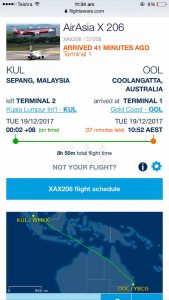

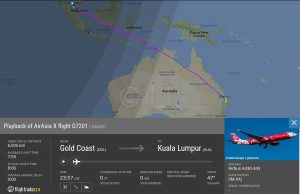
Have a great flight!
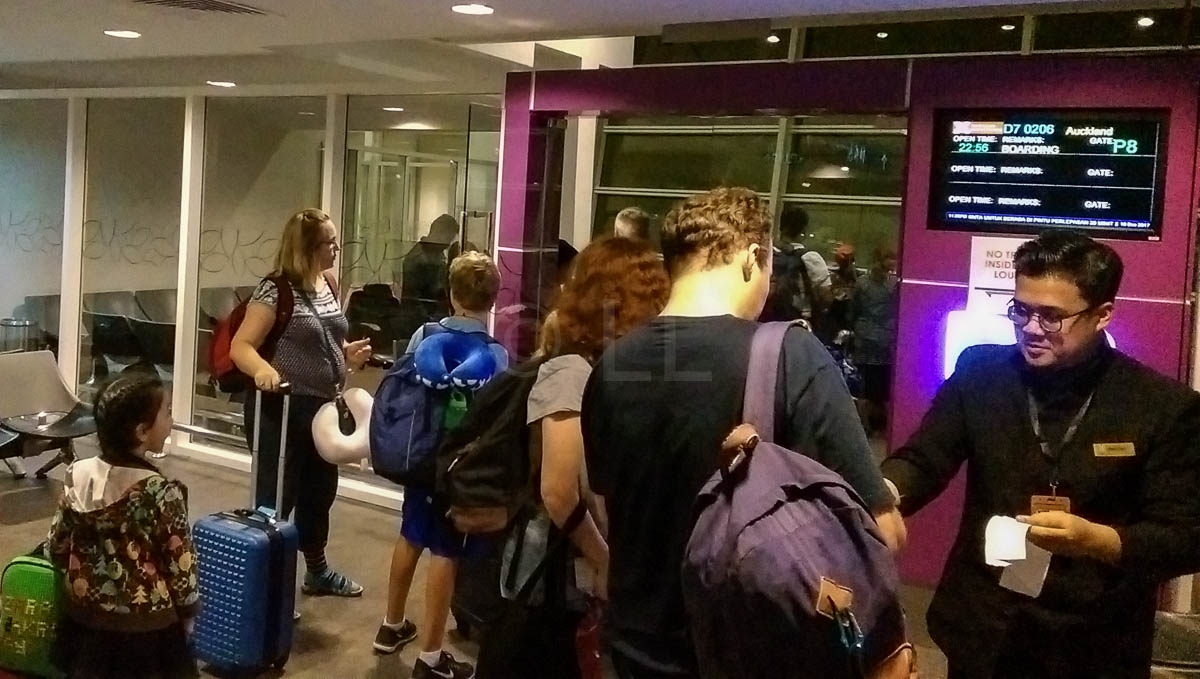
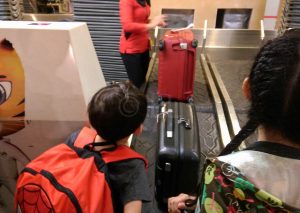
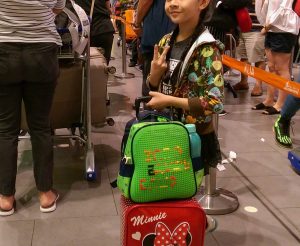


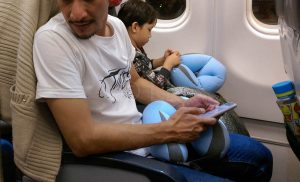

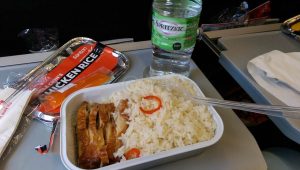
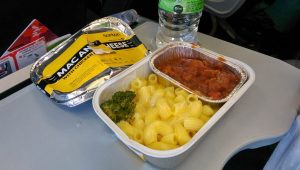
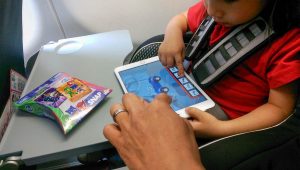
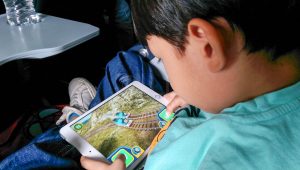
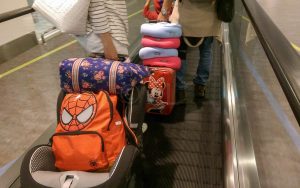
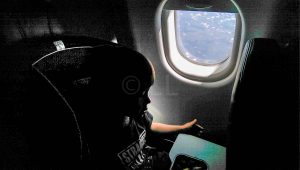






This Post Has 2 Comments
Hi, I would like to know what car seat brand model you use for Air Asia travel?
Thank you.
Hi Eileen,
The brand doesn’t matter so much as the age of the child. If the car-seat is approved for use in the country you’re traveling to, it will be fine.